|
Volcanic
Landforms
At 8:32 a.m. on Sunday morning, May 18, 1980, Mount St. Helens, Washington erupted with the collapse of its north face and an earthquake measuring 5.1 on the Richter scale. In a few minutes, a massive rock debris avalanche slammed across a beautiful valley and its lake, swept across the next ridge knocking down everything in its path, and ripped down the Toutle River Valley. This violent eruption altered the tall, mountain's shape (photos below taken within 2-day span), destroyed 150 square miles of forest, and sent thousands of tons of gray ash into the air to circle the globe. That eruption lasted nine hours. Wet slurries of rock and mud scraped all sides of the volcano. Pumice flows poured down from the crater. The volcano continued to erupt, but gradually decreased in strength until 1986. From that time, it has been quietly building a lava dome inside the crater. Thick, pasty lava oozes out, each eruption piling on top of the next. The lava dome is now over 920 feet high. |
|||||||||||||||||||||||||||
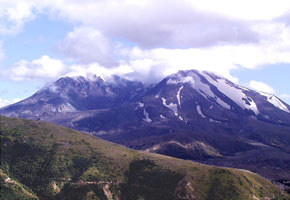 |
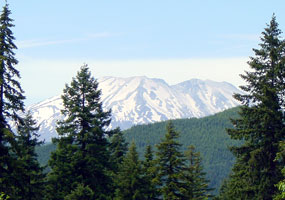 |
||||||||||||||||||||||||||
|
Mt.
St. Helens, North Face & Volcano Crater
|
Mt.
St. Helens, South Face
|
||||||||||||||||||||||||||
| Volcanoes. Volcanoes occur in three forms: hills or mountains built up of (1) hot, molten rock called lava, (2) fragmented rocks, or (3) a combination of lava and fragmented material. At the top of volcanoes, there are circular or elliptical depressions. If they are less than a mile in diameter, they are called craters. If larger in size, they are called calderas (kal-Dare-uhz). Craters and calderas are formed by explosion, collapse, or both processes. | |||||||||||||||||||||||||||
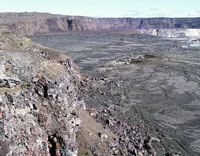 |
The photograph on the left is of a portion of the Kilauea Caldera, a huge volcano on the 'Big Island' of Hawaii. This caldera contains a series of craters within it. There are several active steam vents indicating the molten heat that exists at an estimated two miles below the surface. Today people can hike via several different trails through this Caldera. Kilauea Volcano is still active today. As recently as May 4, 2002, an open lava flow reminded that this is the most active volcano in the world. At other times, there are no surface flows. Instead, the lava sometimes travels down the mountain slope through a lava tube for miles and then erupts undersea next to the shore, creating a steam plume that can be seen for several miles. |
||||||||||||||||||||||||||
| Kilauea Caldera, Hawaii | |||||||||||||||||||||||||||
|
Volcano Profiles. Volcanoes vary in their profiles primarily because of the materials of which they are constructed. Shield volcanoes are relatively flat domes with less than ten degrees of slope. They are formed of silica-poor basalt lava that was hot and free-flowing, thereby creating its gentle contour. Many Hawaiian volcanoes are the shield type. Composite volcanoes are constructed of a combination of lava and fragmented material. They have slopes of about thirty degrees close to their summits and as little as five degrees near the base. Their composition materials reflect alternating periods of explosive and quiet eruptions. Their rock composition is most often andesite, but can range from rhyolite to basalt. Most of the world's largest volcanoes are composite including Mayon in the Philippines, Fujiyama in Japan, and Mts. St. Helens and Shasta in the U.S. Cascades. |
|||||||||||||||||||||||||||
|
Cinder
Cones are formed by an explosive accumulation of volcanic ash and
coarser fragmented material including cinders. This material builds
up around a vent, generally at an angle of thirty to thirty-five degrees,
the angle of rest for loose volcanic fragments. Cinder cones often are
clustered together. Sometimes basalt flows extend outward from their
bases. In 1943, Paricutin
(pah-ree-koo-TEEN) was born in a western Mexican cornfield. When it
ceased erupting nine years later, it was 1,345 feet high - - large for
a cinder cone.
|
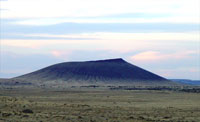 |
||||||||||||||||||||||||||
|
Ancient
Cinder Cone, NE Arizona
|
|||||||||||||||||||||||||||
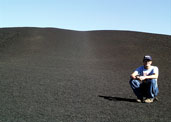 |
Eruptions of basaltic lava fountains powered by explosive gases can build up rough, steep-sided spatter cones. They are composed of pasty blobs or spatters of lava. Generally, this volcano profile is small in size; they usually reach a few thousand feet high. Some lava barely flows or is very sluggish. Silica-rich lava is cooler, thicker, and slower flowing. Sometimes lava heaps up into a steep-sided, bulbous plug dome over its vent. Plug domes are similar in size to spatter cones. Mono Craters in eastern California is an area of plug domes. |
||||||||||||||||||||||||||
| Craters of the Moon, Idaho | |||||||||||||||||||||||||||
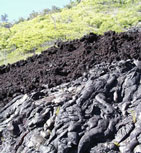 |
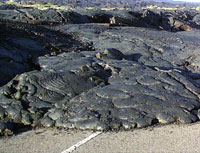 |
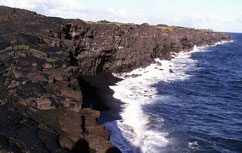 |
|||||||||||||||||||||||||
|
Lava flows, Hawaii
|
|||||||||||||||||||||||||||
|
Composition of Lava. Deep beneath the Earth's crust lies red-hot molten rock, called magma. Magma is a mushy liquid composed of a mixture of melted minerals and mineral crystals. During a volcanic eruption, magma is forced through a weak fissure -- a crack or vent in the surface crust. Regardless of whether the magma is extruded explosively or oozes more quietly onto the Earth's surface; once it emerges, it becomes known as lava. Lava flows (Above photos) are the solidified rock that results from outpourings of molten lava. The rock mass that results from solidified magma is called igneous rock. Molten material that cools and solidifies before it reaches the surface is called intrusive igneous rock. Material that solidifies and cools after it reaches the surface is extrusive igneous rock. All lavas are extrusive igneous rock. Molten rock that solidifies underground tends to cool slowly, resulting in coarse grain structure and mineral crystals big enough to be seen by the naked eye. Conversely, lava that cools and solidifies more quickly on the Earth's surface has a finer grain. The three major types of extrusive igneous rock are rhyolite, andesite, and basalt. A main difference between the composition of these three rock types is the relative amount of silica they contain. Rhyolite is highest or richest (more than 66%) in its silica content. Andesite is intermediate (contains between 52 and 66%). Basalt contains the least silica, is poor in silica content (45 to 52%). |
|||||||||||||||||||||||||||
 |
|||||||||||||||||||||||||||
| Another specialized rock form associated with volcanic lava is obsidian. Obsidian is natural glass, also called volcanic glass, that is formed when lava cools very rapidly. In the photograph to the left, the black, glassy looking obsidian is heaped into a twenty-foot mound within a lava flow. Obsidian forms because it cools so fast that crystals have no time to develop. It is usually shiny and black, but can also be red-brown or gray in color. Obsidian fractures easily into pieces with sharp cutting edges and smooth rounded surfaces. This characteristic made obsidian an excellent material for Native Americans to knap their arrowheads, spearpoints, and other cutting tools. | |||||||||||||||||||||||||||
| Obsidian, Newberry Natl. Monument, OR | |||||||||||||||||||||||||||
| Types of Lava and Lava Flows. Hawaiian terms for lava flows have been universally adopted. Basaltic lava containing low amounts of gas moves slowly and forms flows that are many feet thick. When the lava cools and splits apart, the surfaces of these flows become a rough, jumbled mass of broken, angular blocks and clinkers (below left photo). The Hawaiian name for this type of lava flow is aa (pronouced AH-ah). Basaltic lava that contains greater amounts of gas is thinner and flows more quickly. Its surface quickly cools and retains a wrinkled or ropy-looking surface appearance (below right photo). This type of lava is called Pahoehoe (Pah-HOE-ee-hoe-ee). Revisit the photographs of Hawaiian lava flows (2nd photo group above) and see if you can identify both types of lava. | |||||||||||||||||||||||||||
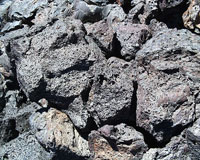 |
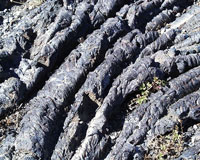 |
||||||||||||||||||||||||||
|
AA
lava
|
Pahoehoe
lava
|
||||||||||||||||||||||||||
| Large, broad areas of lava flows are also called lava fields, especially when they are adjacent to a volcano mountain or groups of cinder cones. Other landforms are often found within those regions. Sometimes flowing basaltic lava going down a moderate slope becomes confined into a channel. If that channel cools slightly and becomes roofed over, the resultant lava tube may continue to conduct molten lava and extend downhill for miles. Those drained, cooled tubes are called lava tubes or lava caves (Photo, below left). | |||||||||||||||||||||||||||
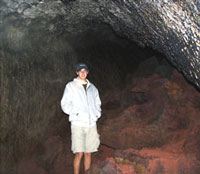 |
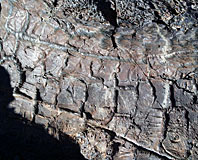 |
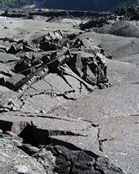 |
|||||||||||||||||||||||||
|
Lava
Tube, Ape Cave, WA
|
Tree
Mold, Craters of the Moon, Idaho
|
Pressure
Ridges, Hawaii
|
|||||||||||||||||||||||||
|
Lava sometimes envelops living plants and retains some of their shape within the lava surface. Occasionally the form of ancient plants are totally encased and preserved in lava. In the center photograph above, the image of the trunk of a limber pine is encased in a lava tree mold. Still molten lava knocked down and ignited the tree. Its charred trunk bark left its impression in the cooling lava rock. In other locations, standing trees are encased leaving vertical molds. Pressure ridges (Above right photo) can form as a seimi-rigid lava surface is squeezed as it interior remains more fluid and flexible. Cracks often adorn the peaks of those ridge formations, and lava and steam may issue secondarily from them. |
|||||||||||||||||||||||||||
| Evolution of Volcanic Terrains. Over time, lava fields undergo progressive changes. Wind and water wear down the volcanic rock, starting with the softer materials. Streams with a steep gradient can sometimes cut through a lava pile. In the ocean, underwater wave action breaks apart the volcanic material. Heating and cooling by sun and seasonal changes further expand and contract the lava masses, aiding in their breakup. These processes move very slowly. Some lava flows in Oregon and Washington states are millions of years old. Eventually plants are reestablished in the nutrient-rich volcanic soil. Insects, birds, and other animal life return. |
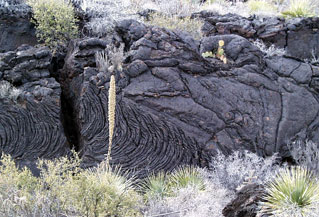 |
||||||||||||||||||||||||||
|
Valley
of Fires National Recreation Area, New Mexico
|
|||||||||||||||||||||||||||
|
More Information If you want to learn more about rock varnish, visit the following websites:
Try a webquest activity. Note:
All photographs taken with a digital camera in Hawaii, Idaho, New
Mexico, Oregon, and Washington. |
|||||||||||||||||||||||||||